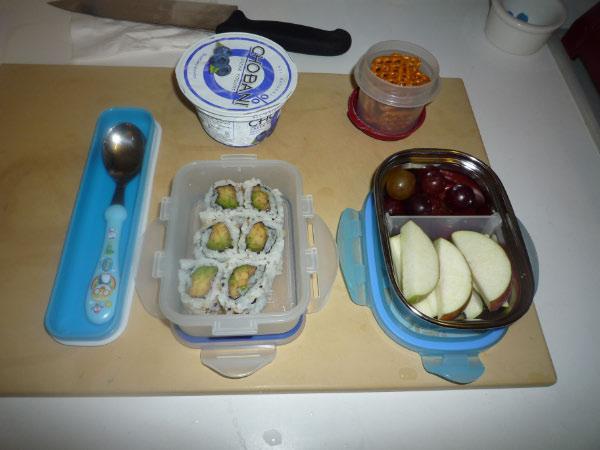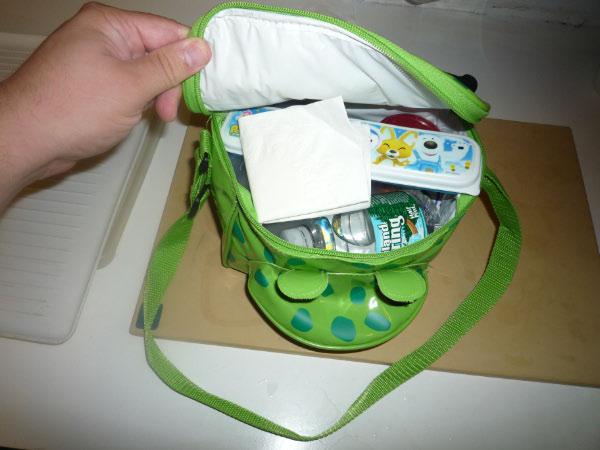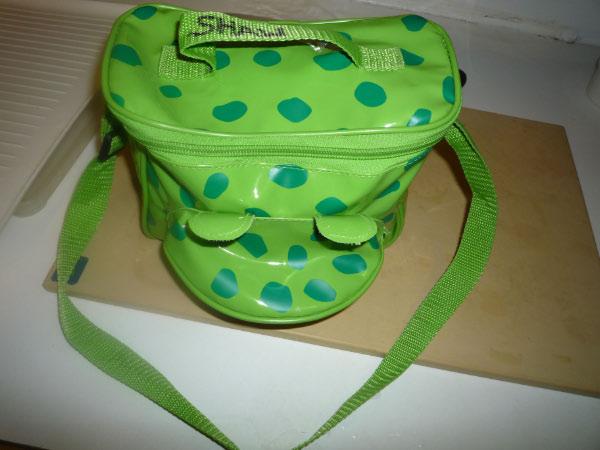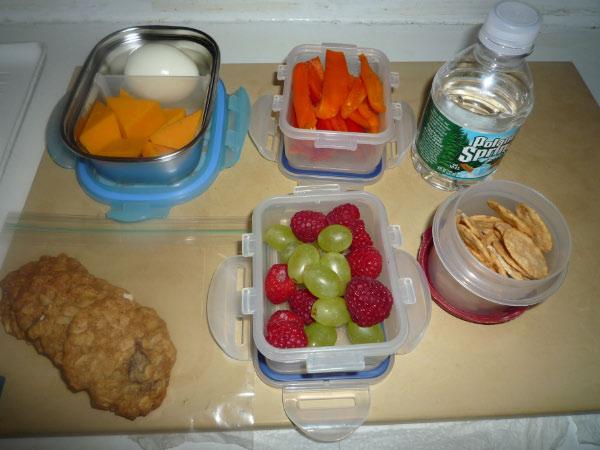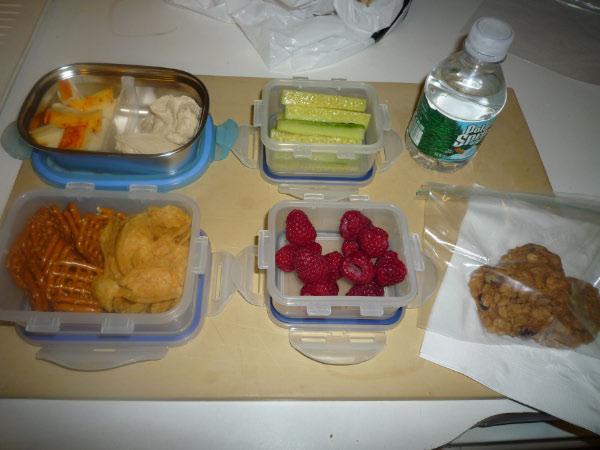-
Posts
28,458 -
Joined
-
Last visited
Content Type
Profiles
Forums
Store
Help Articles
Everything posted by Fat Guy
-
I agree. The numbers sound low. Some googling revealed an alternate statistic, apparently from the Wheat Foods Council: "Americans eat more than 45 billion sandwiches per year, with the average American consuming 193 sandwiches annually" (link).
-
I think the notion of an open-face sandwich is pretty thoroughly accepted in the language, both in common (restaurant menus, everyday consciousness) and in formal usage (newspapers, magazines, books, dictionaries).
-
Heroes, hoagies, grinders, subs, whatever you call them, are not between or atop slices of bread. They're on or in rolls. For comparison, Webster's says "two or more slices of bread or a split roll having a filling in between" or "one slice of bread covered with food."
-
The sandwiches in Colombia may very well be snacks. I'm not sure any sane person could consider a Katz's pastrami sandwich a snack, though. I think the most traditional definition of a sandwich is stuff between two or more slices of bread. But then you can also have something on a split roll. Or open-face on one slice of bread. And then there are sandwich-like things where the ingredients are between two pieces of non-bread, like the KFC Double Down (between two fried chicken breast patties) and Junior's "Something Different" (brisket between potato latkes). Then you have wraps and related items like burritos. With each of those categories you move farther from the traditional definition, but the history of defining food terms is one of expansiveness so I'm not sure where I'd draw the line.
-
I'm pretty sure the Vita-Prep units they market to smoothie places have automatic cycles and sound enclosures. The market consensus just seems to be that the Blendtec models are better for that application. Or it could just be the herd mentality, or effective sales and marketing. For example, when I asked the guys at a local restaurant, Beacon, why they chose the Vita-Prep they said "Because that's what our supplier carries." A lot of restaurant purchasing decisions are made that way. I can't speak from experience on the question of professional Blendtec v. Vita-Prep models. What I can say is that the home Blendtec Total blender seems like a better product than the equivalently priced Vita-Mix 5200. I've owned both for enough cycles to be pretty sure about that.
-
I just made today's brisket sandwich on Trader Joe's Honey Bran Country Bread.
-
I've recently been twice to a Dongbei (Northeastern) Chinese restaurant in Queens, NY, where they serve a pretty interesting dessert. Chunks of apple, taro and sweet potato are coated in a hot sugar syrup. Alongside, they serve a bowl of cold water. You take a chunk with your chopsticks, dip it in the cold water, and the sugar seizes up and becomes a crunchy-chewy candy shell. As I was dipping yet another piece, watching in amazement, it occurred to me that if you brought out those same chunks of sweet potato -- say, just three of them -- on a black granite slab and presented the whole thing with great ceremony you'd have a dish that could feel at home at El Bulli. This got me thinking about the continuum of non-modernist foods that lean heavily on food science, consciously or not. I kept thinking of examples: bread, Jell-O, Hollandaise, marshmallows... And then I thought, hey, there's this online community of food lovers who might like to discuss this point.
-
The convenience of the sandwich is definitely one big point in favor, but sandwiches are also really good at least potentially. And we do sandwiches very well in America. Most of my sandwich experiences in other nations have revealed limited if not impoverished sandwich cultures. Whereas here, sure, you have many of the expected crap sandwiches consisting of lunch meat on squishy white bread, but you also have an incredibly diverse culture of sandwich artistry cold and hot, high and low. Porchetta, banh mi, lobster roll, PB&J, ham and cheese, egg salad, cuban sandwich, BLT, Italian-American deli (salume of all kinds), Jewish-American deli (pastrami, chopped liver, bagel with lox and cream cheese), nouvelle chef-driven deli ('wichcraft's marinated white anchovies), relatively high-quality chains (Panera, Quizno's), croque monsieur, Monte Cristo, muffuletta, cheesesteak, barbecue, Reuben, panini, burgers, sliders, meatball parm, hot open-faced, club, tuna melt, gyros, bacon-and-egg, churasco, po' boy, falafel, shawarma, Chick-Fil-A, McRib, Egg McMuffin, Filet O' Fish. That's just a starting point. As you read that list, if you're someone who eats sandwiches, you'll have dozens to add ("Hey you forgot grilled cheese!") and lots of questions ("Do wraps count?") . And then if you circle back to the convenience factor you have situations where you have a stand-alone good food product and the sandwich format is probably the best way to convey it as a portable lunch. For example earlier this week I braised a brisket. My son wanted brisket in his school lunch on Wednesday. I couldn't really think of a better way to get brisket into a school lunch so I put some cold sliced brisket on good bread with Russian dressing. He liked it so much he requested it again the next day. And he has asked that I make it again this morning.
-
The ones I seem to use the most are the 6 ounce and the 11 ounce, both rectangular, which doesn't mean I couldn't use smaller ones.
-
I guess I could come up with various solutions, but my preferred solution is to use a container that won't leak. This is particularly so given that Lock & Lock containers tend to be cheaper than the ones that do leak! The whole uprightness issue just isn't a consideration in American schools, where something like 99% of the kids who brown bag it on any given day come with a sandwich or something that doesn't need to be upright. I forgot this morning to take a photo of the big pile of lunches at our son's school. I'll try to illustrate that one day soon.
-
There's a Lock & Lock store?!?!?! I want to live there. I don't pack things like soup, but something like the water given off by raspberries can easily wind up at the bottom of his lunch bag if the container gets inverted and doesn't have a good seal. Unfortunately the level of lunch-making at American elementary schools is so low there's no thought given to keeping things upright. Rest assured the fact that Chris Amirault and I are talking about these issues makes us total outliers.
-
The Lock & Lock containers, made in Korea, that we've been using have been excellent. They've endured through many, many dishwashings. They're air- and water-tight. They're very easy to open and close. And they're cheap: they tend to clock in around $3 (US) each. So when I see other containers that cost many times as much and don't have a real locking mechanism, and when I combine that with my own bad experiences with such containers either being leaky or difficult for PJ to open, I find it hard to justify a non-Lock & Lock purchase. The no-leak issue is important for us because the kids' lunches are thrown in a big sack together and it's easy for them to get inverted and knocked around. That doesn't matter for every food item under the sun, and I suppose it's possible to pack dry foods in certain containers and wet foods in others, but I don't want to have to make such distinctions at 6:30am. The only problem is that the Lock & Lock containers are kind of boring aesthetically. Pretty much the best I can do is get some with different colored gaskets. If they came in cool designs I'd be thrilled. Somehow long ago at H-Mart we got a Lock & Lock knockoff with a stainless dish and a lid decorated with Pororo, who I believe to be a Korean anime penguin. That has been our number one container. I have no idea how to track down its kin, though.
-
Are the containers easily openable and closeable, as well as relatively air- and water-tight? Our experience with anything other than snap-lock-type containers is that they're either leaky or difficult for little fingers to open.
-
Plenty of offices have full kitchens. They tend to be smaller offices in single-story or house-like structures, or in older low- and mid-rise buildings. In high-rise office buildings, for the most you can't have a proper kitchen without installing some pretty serious ventilation and fire suppression. So you're limited to things like microwaves and toasters.
-

How do you carry your SLR to and in a fine dining restaurant?
Fat Guy replied to a topic in Restaurant Life
I think the best solution is to have a really cool looking camera, like a Leica S2. Then it becomes the equivalent of a strand of pearls: a fashionable accessory with any outfit in any situation. Short of that, I think a fitted leather case -- one that conforms to and holds just the body with a single lens -- has a nice retro look. Rokinon is one brand that seems to be around. They run about twenty bucks. -
One thing I need to do is get some new lunch containers. Maybe you all can help. These are the requirements: 1. Has to be available in the US (preferably from Amazon). 2. Has to be easy for little hands to open (the Lock & Lock containers are great; most others haven't worked as well). 3. Has to be modular, i.e., not a big single lunch box but rather a little container that can be mixed and matched with others to make up a lunch kit.
-
PJ started kindergarten a couple of weeks ago. Between a phased adjustment schedule, a couple of days off for holidays, and a half day last Friday, he has only had three lunch days in two weeks. The rules this year are different. He's in a New York City public school now so there are essentially no rules: no restrictions on what he can bring (doesn't have to be kosher, dairy, nut-free or anything else), no brown-paper-bag requirement, and they don't refrigerate the lunches. These changes should allow for some exploration and increased interest in lunch-making this year, but for the first few lunches we went with the familiar. This coming week I'll start adding some new items into the rotation and we'll see what works.
-
I'm curious: is there scientific research in support of the claim that "breakfast jump-starts the metabolism"?
-
It would be amusing if, after all that complex investment, marketing, branding and aesthetic cleverness, McDonald's simply decided to make the food better and that increased demand. I guess the research indicates that people just don't care if the food is good?
-
I think the elephant in the room here is the issue of bodily functions. No meal is more tied to "regularity" than breakfast. Many if not most people time their morning routines around elimination, and breakfast can have a significant effect on things. I think the body-function issue is a big part of the reason why people the world over are the least adventurous when it comes to breakfast foods: they demand the familiar.
-
I love, love, love breakfast. I wish I could wake up every morning to a groaning board of eggs, bacon, sausage, buttered toast, fruit, cheeses, fresh-squeezed juice and more. But there would be issues with that: For one thing, I'd have to go right back to sleep. For another thing, if I managed to stay awake, I wouldn't be able to do much without serious heartburn and other gastrointestinal repercussions. And for still another thing, I'd weigh an extra 100 pounds. So most days I make a smoothie, but if I'm tight on time I skip it.
-
I must agree strongly with this summary. The rules of the game on Top Chef allow this kind of crazy victory. Those rules are not chosen as a means of determining the best chef, but rather as a means of maximizing entertainment value, suspense, ratings, advertising -- all the stuff that makes TV tick. It doesn't matter how much integrity Colicchio has as a chef or as a person. He has plenty. But he's not the producer, director, editor or anything like that. He's talent. He plays the role of the chief judge. He evaluates the contestants according to the rules of the game. He does that well. It doesn't mean Kevin can't beat Angelo.
-
I've noticed that in other people's kitchens there's a decent chance that the cutting board will be a thin plastic sheet, giving minimal knuckle clearance.
-
The Society is pleased to welcome several new bloggers and other online writers and outlets as eG Ethics code signatories: Eat in OC The Tea Archive Mark Cooks Scott Can Cook Luscious Repast From the Southern Table Conversations at the Wienerburger Diner A Canadian Foodie Don Lucho Upstart Kitchen On Golden Fond The Wright Table Seattle Food Geek Pen & Fork Indirect Heat Alexandra Forbes In addition, we would like to welcome the following eGullet Society individual member signatories: "mollyf" "Lisa Shock" "T Raveret" "Monique" "PedroG" "Banana Lady" "Leslie Craven" "BadRabbit" "J.J. O'Leary" "donnalabel" "Mickey Berman" "ray goud" "Dick Atchison" "Porthos" "David Wondrich" Welcome all! If you're interested in learning more about the eG Ethics code, or you wish to become a signatory, please visit egullet.org/ethics.
-
My system for getting two good poached eggs is to poach at least three eggs. If you follow all the other general guidelines of poaching, you usually get two out of three and sometimes you do better. Eggs are so cheap that, whenever I poach, I poach extras. The extras can be refrigerated in ice water and reheat very well. Most people I know who rely on the vortex method are using too little water.


